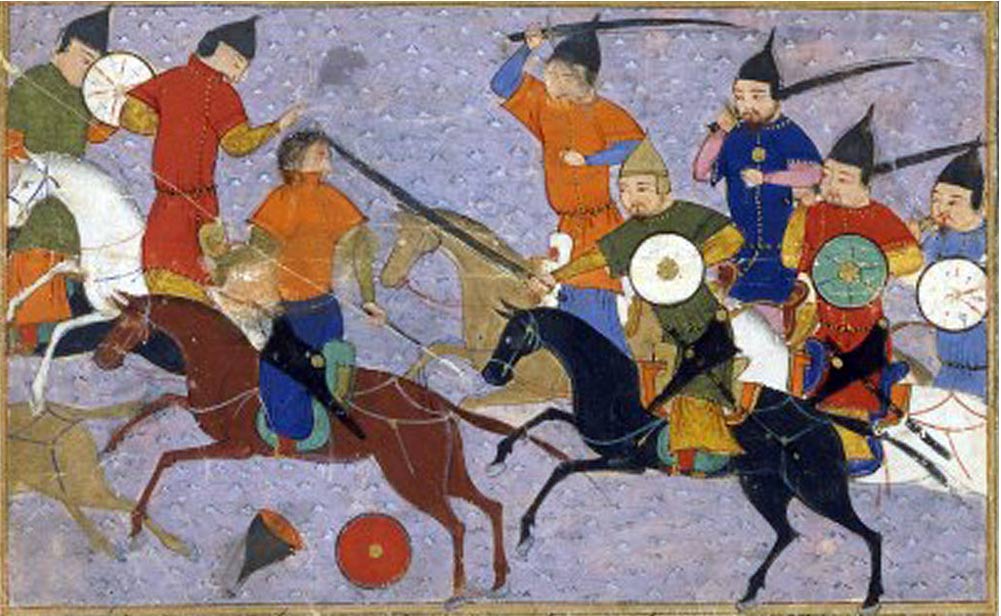
Dogs of War: Ancient History of Animals in Warfare
Man and beast have partnered for various reasons over tens of thousands of years—almost always for food or protection. The dirty history of animals in warfare is sometimes inspiring, sometimes disturbing, but without the aid of creatures in war, humanity would be in a different place than we are today.
The image of a mounted warrior succinctly captures the history of animals in war, but many animals, such as dogs, camels, elephants, pigs, oxen, dolphins, pigeons and more, have all served in various capacities and have played roles (for good or ill) in war and combat related activities. Some animals were inhumanely weaponized, while others were beasts of burden and transportation. Still others filled the role of mascots to boost morale.
Horses
It can be said that horses have played the greatest and widest role in the history of animals in warfare. Evidence points to horse domestication as early as 5000 BC in Kazakhstan. Initially they were used for food and milk, but it wasn’t long before they served as the mainstay of warfare; from the time man recognized the advantages of using the tall, strong, maneuverable beasts in battle, until they were replaced within the last 100 years with motor vehicles.
In ancient China and Egypt, the horse was used to pull chariots and ‘proto-chariot’ platforms.
Later, with the invention of the saddle and stirrup, and the breeding of heavier horses, battle tactics forever changed, as mounted warriors proved a decisive advantage, delivering devastating charges from the backs of fierce, trained animals. The riding and arrow-shooting combination was a technique perfected by the Mongols, who used it to effectively conquer most of Eurasia and establish an empire.
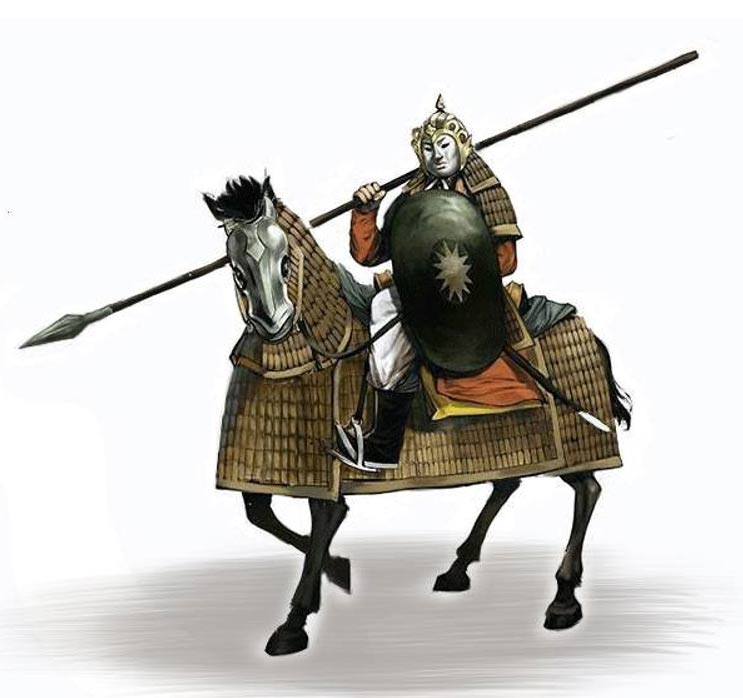
Dai Viet heavy cavalry of the Tran Dynasty (1225–1400 AD). Both horse and rider had protective armor. Wikimedia Commons
In Europe the mounted warrior was considered the most prestigious force, and their warhorses were trained to kick and bite.
Possessing a fine horse became a designation of status, and often only the wealthy could afford them.
Cataphracts, or heavily armored cavalry, were used in ancient warfare across Western Eurasia by many peoples. The horse and the warrior were both heavily protected, usually enclosed head to toe in scale armor. The horseman would wield a lance as a weapon. These fearsome forces would often serve as elite cavalry, using charges to pierce through infantry lines. It is these warriors and war horses that are believed to have influenced the well-recognized European knights.
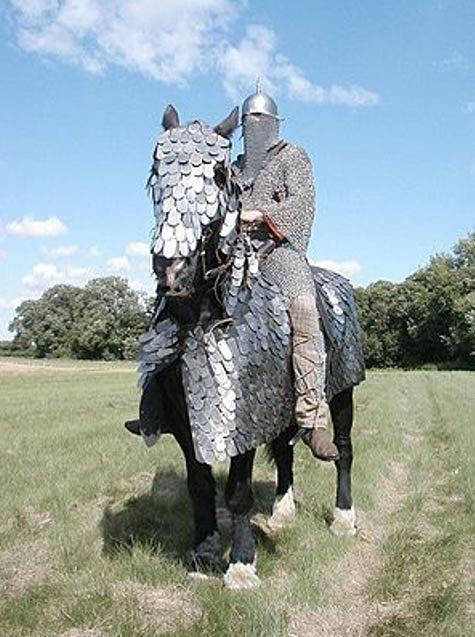
Historical re-enactment of a Sassanid-era cataphract, complete with a full set of scale armor for the horse. Note the rider's extensive mail armor, which was de rigueur for the cataphracts of antiquity. Wikimedia Commons
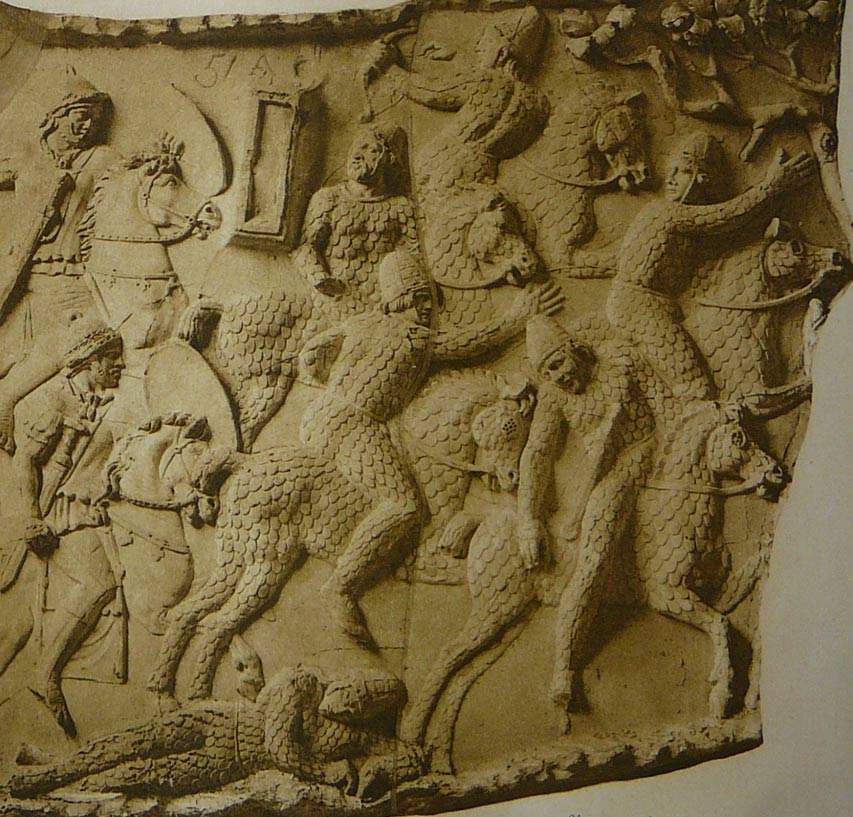
A depiction of Sarmatian cataphracts fleeing from Roman cavalry during the Dacian wars circa 101 AD, at Trajan's Column in Rome. Public Domain
A horse isn’t suited for all terrains or jobs, however, and that is where other animals entered the fray.
Dogs
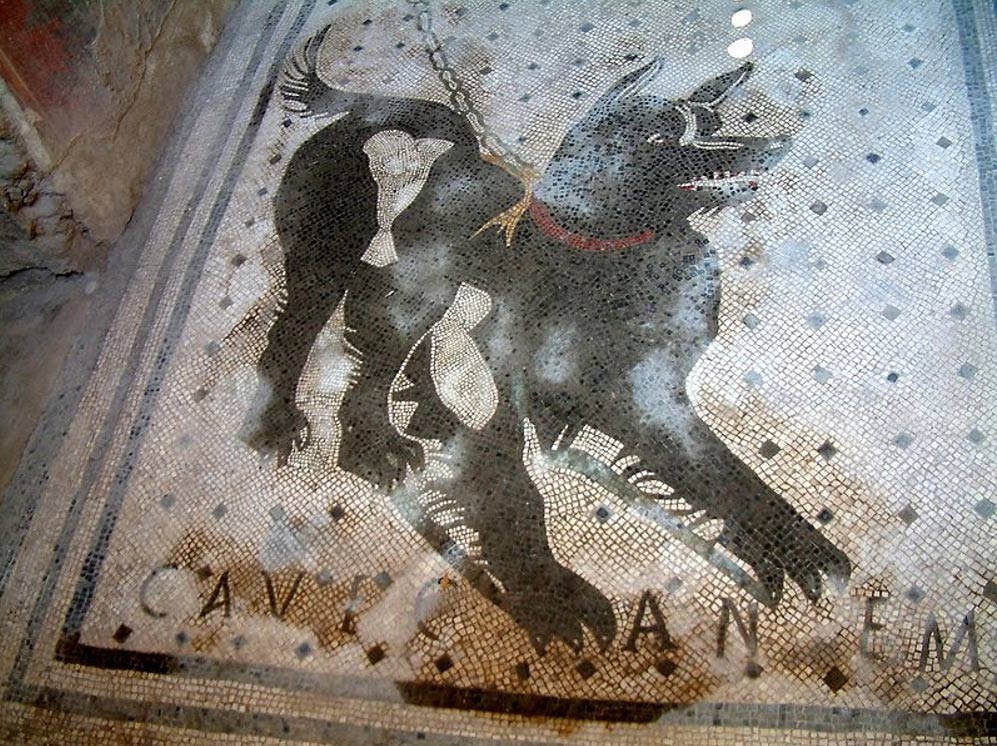
Cave canem mosaics ('Beware of the dog') were a popular motif for the thresholds of Roman villas. Wikimedia Commons
Often dubbed man’s best friend, dogs have been partnered with humans and used in warfare since their domestication more than 50,000 years ago. Not just for attacking, work hounds were used for protecting livestock or property, or for simple companionship. War dogs were used by Britons and Romans, Greeks and Egyptians, Persians, Slavs, and others.
The earliest written account of war dogs comes from a classical source regarding Alyattes, King of Lydia. The war dogs are said to have attacked and killed invaders in a battle against the Cimmerians around 600 BC.
In antiquity, troops from Anatolia used war dogs in conjunction with cavalry. Riders were said to release their hounds on the enemy to disrupt and soften lines, and then the mounted warriors would charge, to devastating effect.
Xerxes I of Persia invaded Greece in 480 BC and brought large packs of Indian hounds.
War dogs are said to have been present at the Battle of Marathon, dating to 490 BC, between the Greeks and Persian Empire.
Centuries later the Roman army used various breeds of work and war dog, but it is recorded the heavy and capable Canis Molossus or Molossian was specially bred just for combat.
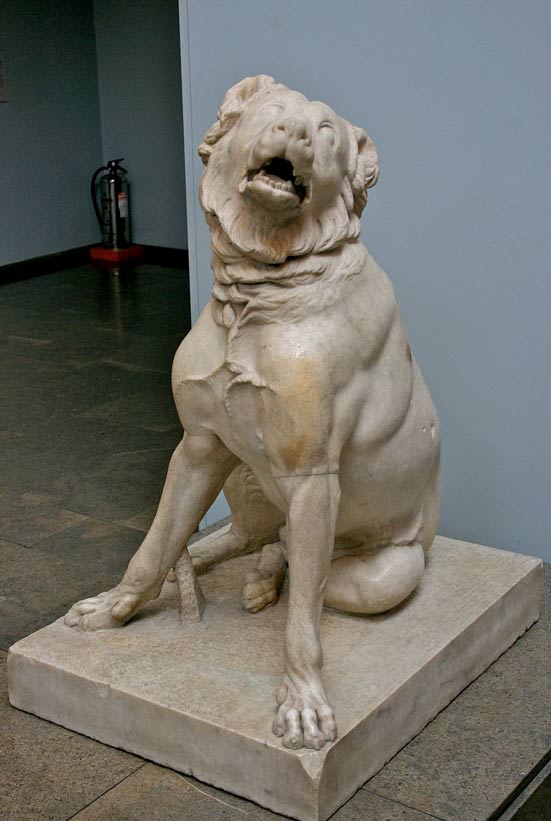
Molossian Hound. The version is sometimes known as "Jennings Dog". On display in the British Museum. Wikimedia Commons
The Celtic warriors challenged Caesar’s landing in Britain in 55 BC with their intimidating English Mastiffs. Mastiffs are cited as one of the oldest recorded breeds, since Caesar described them in his accounts.
In the late middle ages, Spanish conquistadores used fighting dogs which were equipped with padded armor and spiked collars. These rampaging animals were enormous, fast, and extremely deadly. What’s more, the indigenous people of the New World had not experienced horses or war dogs or the terrifying psychological battle tactics, and were overwhelmed.
Author and researcher Graham Hancock describes the ruthless and brutal efficacy of an early trained war dog in his book “War God”. The Spanish used animals as weapons of war against the Aztecs in the 1500. The European use of the war horse and dog in the conquering of the New World fundamentally shaped history and changed warfare. Hancock writes:
The Aztecs had dogs. They were small, hairless, timid creatures, related to the modern Chihuahua, which were reared not as pets but as a food source. Accordingly when the Aztecs first met the Spanish war dogs – wolfhounds, greyhounds, lurchers, pit bulls and gigantic mastiffs similar to modern Rottweilers, they had absolutely no idea what they were dealing with. Indeed they did not think these animals were dogs at all. They thought they might be some species of dragon – an impression compounded by the fact that the Spanish dogs were armored in chainmail and steel plate like their masters and were thus almost invulnerable to stone weapons.
Fasted before battle so they were in a state of voracious, slavering hunger, trained to fight and kill with the utmost ferocity, these terrifying animals already relished human flesh having been used repeatedly in acts of genocide against the Indians of Hispaniola and Cuba. Unleashed in snarling, baying packs, their tongues lolling, drool dripping from their fangs and sparks of fire seeming – in the imagination of the victims – to flash from their eyes, they tore into the Aztec front lines with devastating effect, disemboweling men, ripping out their throats, feasting on their soft, unarmored bodies.
“They have flat ears and are spotted like ocelots,” reported one Aztec eyewitness of the Spanish war dogs. “They have great dragging jowls and fangs like daggers and blazing eyes of burning yellow that flash fire and shoot off sparks. Their bellies are gaunt, their flanks long and lean with the ribs showing. They are tireless and very powerful. They bound here and there, panting, their tongues dripping venom.”
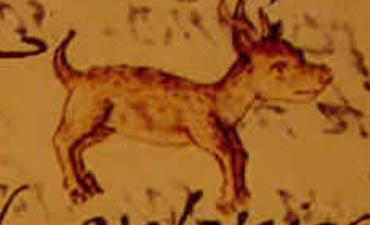
A Techichi, likely the ancient ancestor of Chihuahas, and the small canine the Aztecs would have been familiar with — not a good defense against Spanish war dogs. Wikimedia Commons
Later in the 20th century, dogs would even be weaponized as suicide bombers. At the outset of the Nazi invasion of the Soviet Union, the Russian military is said to have strapped explosive mines to dogs who were trained to go under German tanks, and blow up, taking out the enemy (and dying in the process). However, the dogs were just as likely to duck under Russian tanks or jump into friendly trenches, wreaking unpredictable havoc. It was a failed tactic that didn’t last, thankfully.
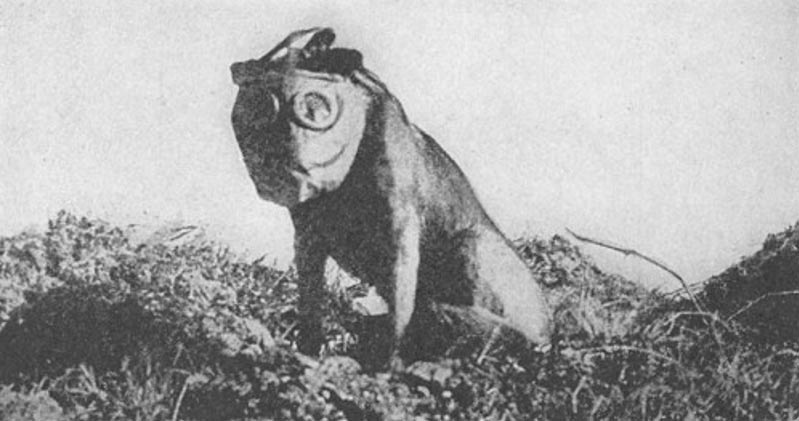
A dog employed by the Sanitary Corps during World War I to locate wounded soldiers. It is fitted with a gas mask. Public Domain
Elephants
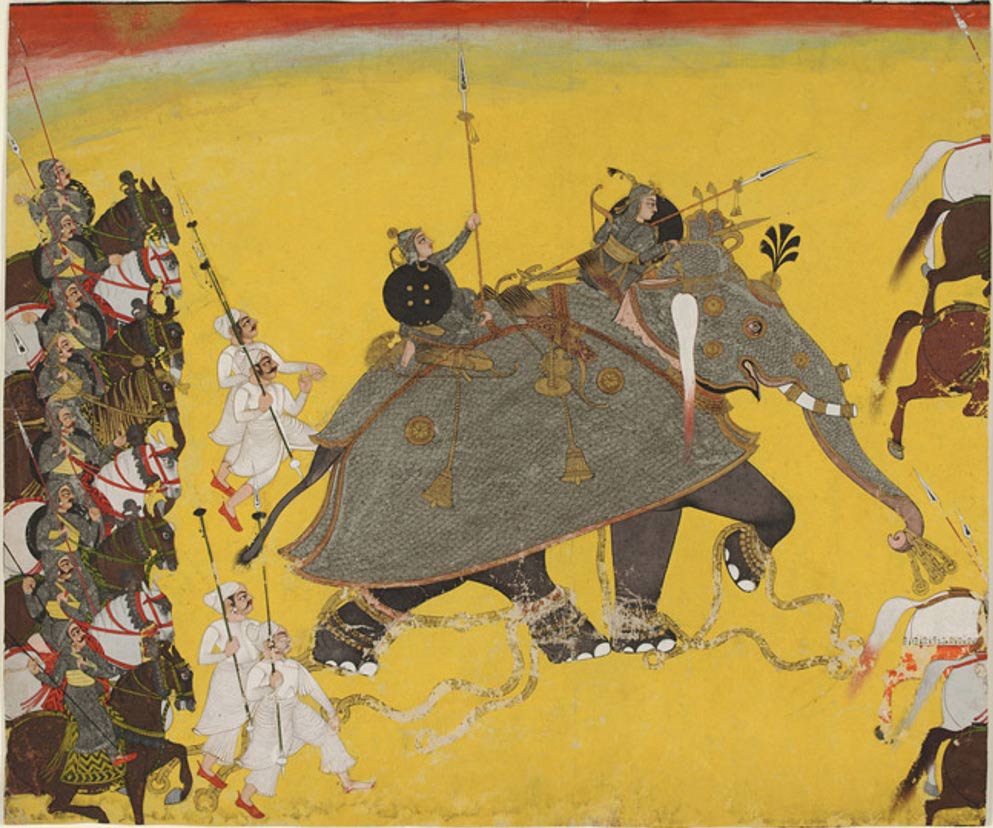
Elephant in Battle, Kota, Rajasthan, India circa 1750-70. Public Domain
Hannibal of Carthage may have dogged the Roman Empire, but he did so most famously with war elephants. His surprising and audacious move of treking through the Alps with war elephants in 218 BC secured his legacy in history as much as his notable skills as a tactician and leader.
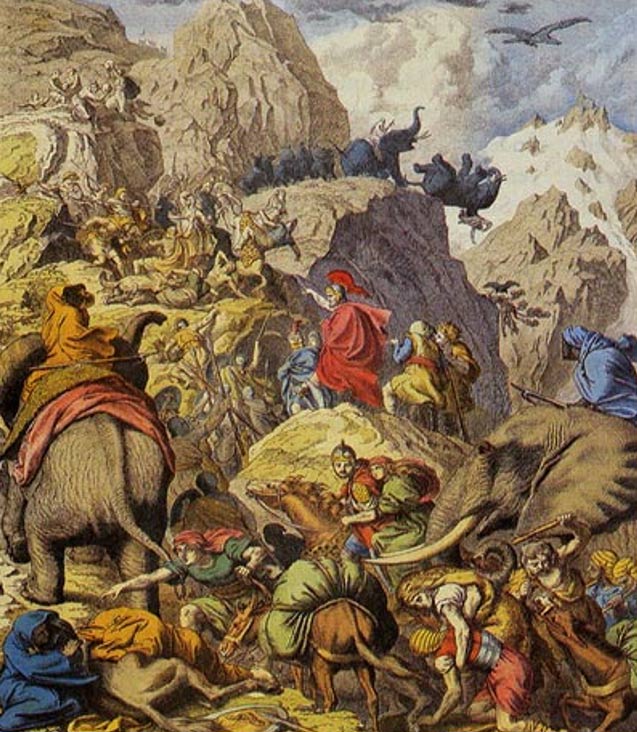
Hannibal and his men crossing the Alps on the backs of war elephants and horses. Public Domain
It is not known precisely when elephants were first used in warfare. It is chronicled that as early as the second and early first millennia BC that the giant creatures were used for transport of people and goods, but it was not until the fourth century that fighting elephants were mentioned as part of Indian king’s armies. They were used widely across most parts of South Asia and North Africa.
The trained elephants were ridden by humans in combat (these warriors are referred to as Elephantry), but their most effective move was to charge an enemy line and cause panic and fear, breaking and scattering the ranks. Certainly the weight and power of an elephant could devastate anyone standing before it.
Use of the impressive war creatures spread, and eventually influenced Alexander the Great’s campaigns. It is said that Alexander was so impressed by the Persian war elephants at the Battle of Guagamela in 331 BC that after he defeated the enemy he took their elephants to use in his own army.
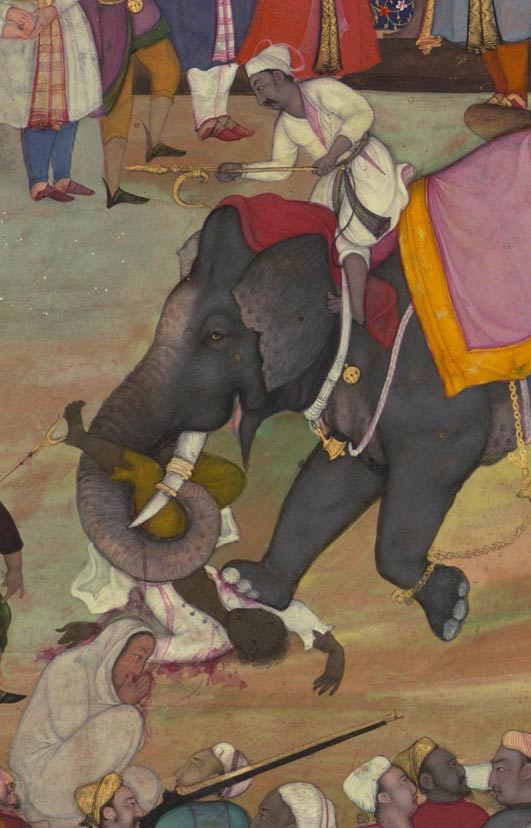
War elephants of the Mughal Empire carry out an execution. Public Domain
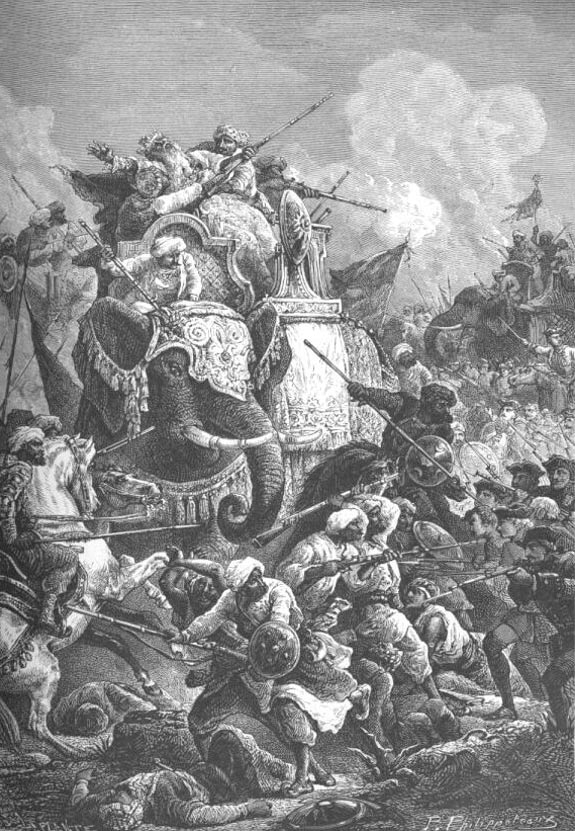
Elephant Howdah were used extensively during the Carnatic Wars and the Anglo-Mysore Wars. Public Domain
The large, wooden seat or carriage on the back of the war elephant is known as a howdah (or houdah). Not only was it a way to seat a rider, it eventually became a symbol of wealth for an owner, and the howdah were elaborately decorated, sometimes with rare gems.
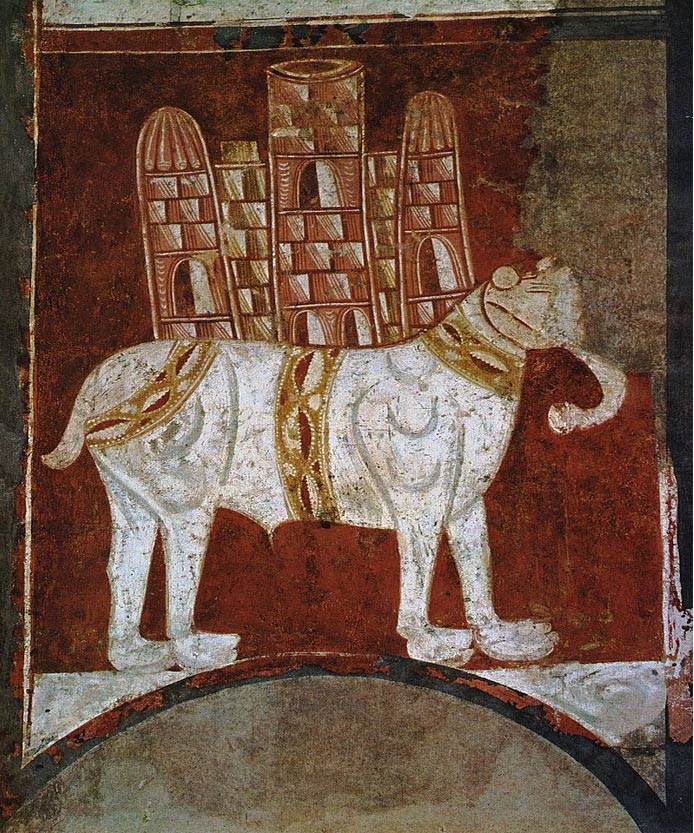
12th century Spanish painting of a war elephant. The elephant carries an elaborate howdah. Public Domain
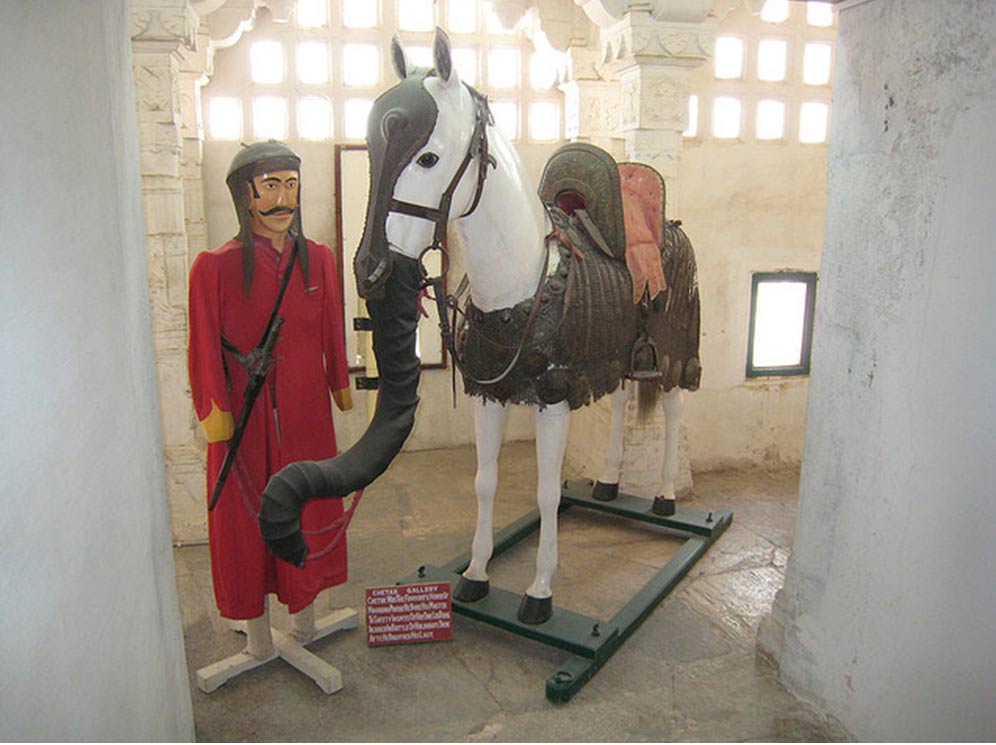
The Mewars of western India attached armor and false noses to their horses. It was said to fool their opponents' war elephants into thinking they were baby elephants so they wouldn't attack. Todd vanGoethem/(CC BY ND 2.0)
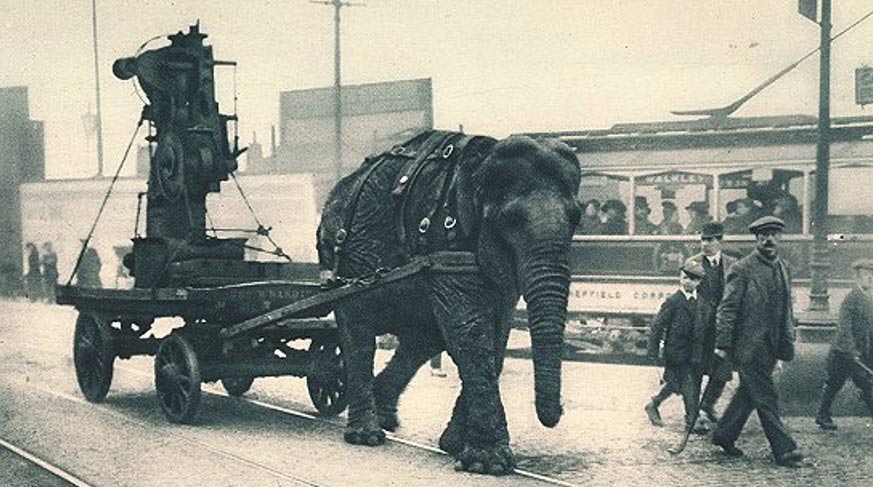
As recently as World War I elephants were used to draw heavy machinery or ordinance. This one worked in a munitions yard in Sheffield, England. Public Domain
Pigs

The pig, an unlikely weapon of war. [This file comes from Wellcome Images, a website operated by Wellcome Trust, a global charitable foundation based in the United Kingdom. (CC BY 4.0)]
Surely nothing could stop a stampeding war elephant on the field of battle, but ancient chronicles mention one thing that may have challenged them—pigs.
Pliny the Elder wrote about war pigs as a countermeasure to elephants. He recounted that “elephants are scared by the smallest squeal of the hog.” They reportedly feared the sharp screams of pigs so much they would panic and turn, upsetting the tide of battle and bringing danger to any man (friend or foe) who was in the path. Pliny wrote that the Romans used squealing pigs in 275 BC to repel the war elephants of Pyrrhus.
Even more horrifying, however, are the chronicles of incendiary pigs, or flaming pigs. There are, tragically, historical accounts by the military writer Polyaenus that the siege of Megara in 266 BC was broken as the Megarians coated pigs with resin, combustible pitch, and crude oil and set them on fire. The shrieking, flaming pigs allegedly were driven toward the enemy lines and so terrified the elephants that great numbers of soldiers were trampled to death in the ensuing flight.
Other ancient historians have noted that early attempts at launching angry lions against enemy armies and their war elephants met with catastrophic results for both sides.
Camels
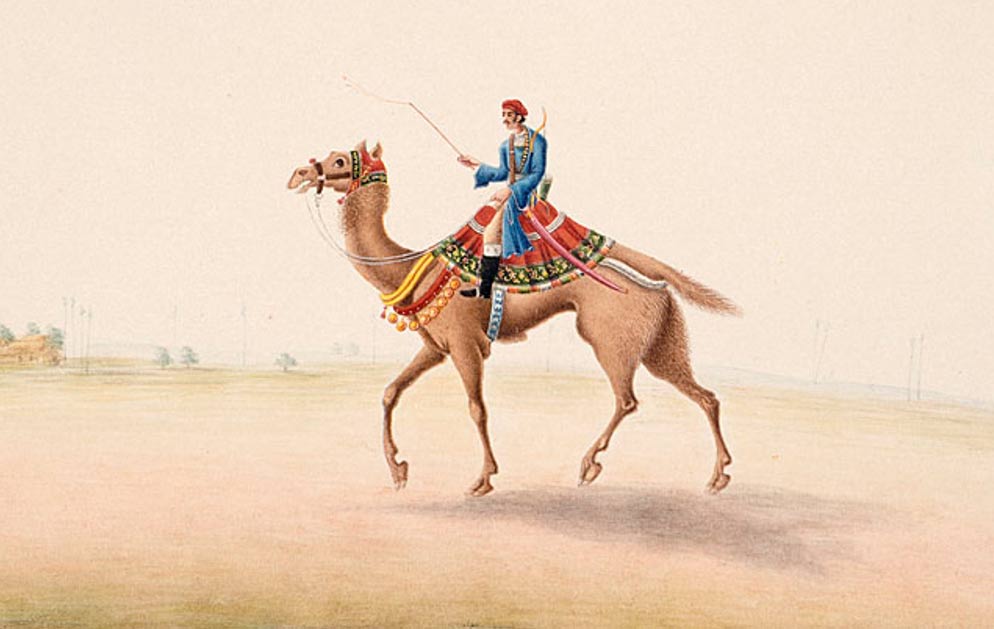
A camel rider in Bihar, British India in 1825. Public Domain
Camels have played a large role in wars, especially in arid regions, and are common to desert warfare. They were, and are still used for transportation. Historically, Camel Cavalry warriors, or Camelry, would fight from the backs of the sure-footed, hardy camels with spears or bows.
Camel cavalries were common and practical as the animal is very adaptable. In the dry, waterless conditions the camel thrived where the horse was less common and not as effective. In addition, it was believed the scent of camel disturbed and alarmed horses, and folklore has them as potent anti-horse cavalry weapons for this reason.
Roman Emperor Claudius is said to have used camels specifically to target the powerful horse cavalries as part of his invasion force into Britain in 43 AD. These troops were known as Dromedarii.
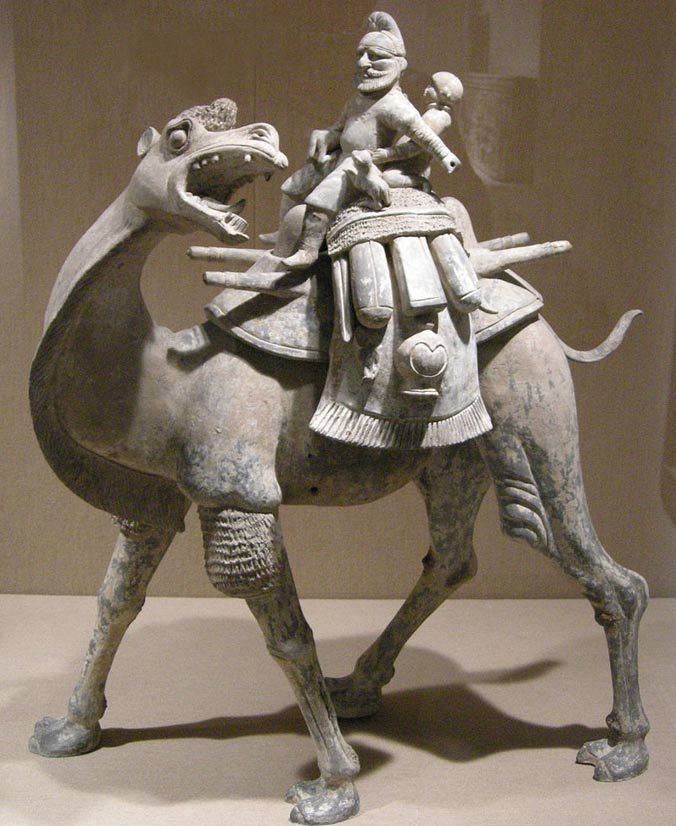
Camel with rider, earthenware, Tang Dynasty. Sailko/(CC BY SA 3.0)
Cats
What could be more difficult than herding together notoriously-uncooperative cats and using them as a weapon of war? Cambyses II, King of Persia used cats to attack the Egyptians during the Battle of Pelusium in 525 BC. He used the felines as a psychological weapon, understanding well the reverence the Egyptians had for cats and other animals.
Professor of Philosophy at Marist College, New York, Joshua J. Mark writes of Cambyses’ psychological warfare using animals:
“Cambyses II, knowing the veneration the Egyptians held for cats, had the image of Bastet painted on his soldiers' shields and, further, "ranged before his front line dogs, sheep, cats, ibeses and whatever other animals the Egyptians hold dear" (Polyaenus). The Egyptians under Psammenitus, seeing their own beloved goddess on the shields of enemies, and fearing to fight lest they injure the animals being driven before their foe, surrendered their position and took flight in a rout. Many were massacred on the field and Herodotus reports seeing their bones still in the sand many years later; he commented on the difference between the Persian and the Egyptian skulls.
Psammenitus was taken prisoner and was treated fairly well by Cambyses until he tried to raise a revolt and was executed. Thus ended the sovereignty of Egypt as it was annexed by Persia and, henceforth, changed hands many times before finally ending up as a province of Rome. It is said that Cambyses, after the battle, hurled cats into the faces of the defeated Egyptians in scorn that they would surrender their country and their freedom fearing for the safety of common animals.”
Warfare and the history of the human world, has been shaped by our relationship, use of, and partnership with animals. Creatures of the air, sea, and land continue to be partnered with humans in modern global conflict, from bees that are used to detect landmines in Croatia, to dogs who detect explosives in Afghanistan, and dolphins who use echolocation to locate sea mines.
Thankfully, today many of the historical military uses of war animals have shifted into peacetime purposes, such as crowd control, as military mascots, in ceremonial exhibitions, reenactments, and competitions.
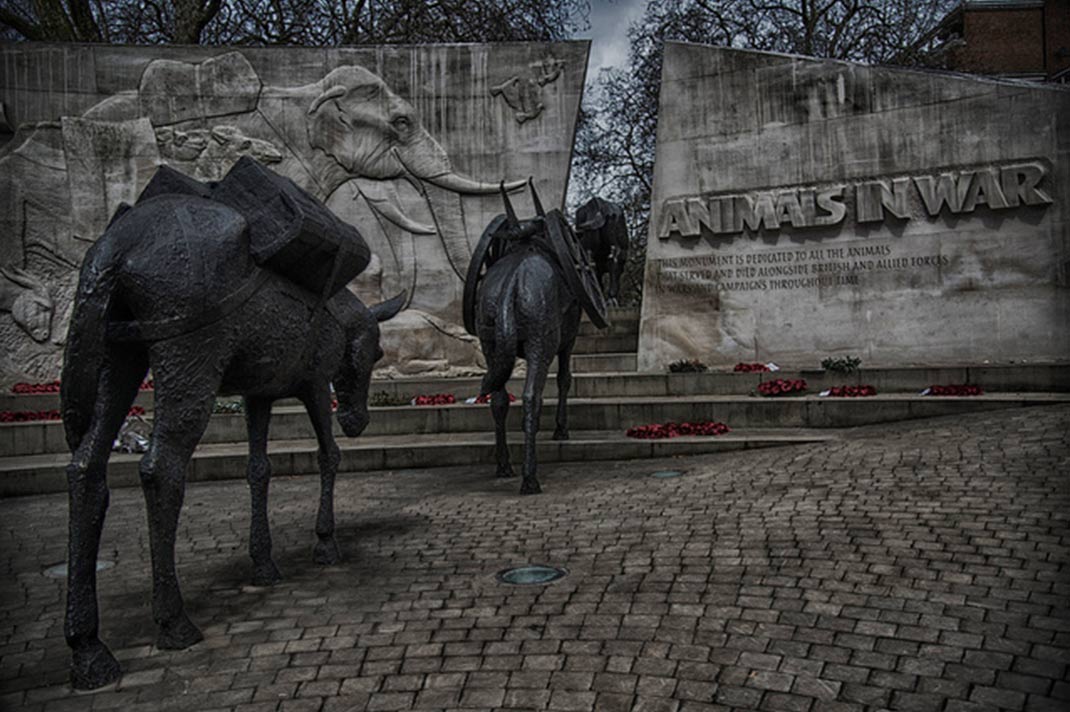
Animals In War memorial, Hyde Park, London, England. marco monetti/(CC BY ND 2.0)
Animals have long fought and died in battle alongside humans, but despite the dedication and valor we attribute to the animals, war animals have fought involuntarily. Many countries have monumental tributes to war animals. A memorial to animals of war in London, UK, is dedicated to those which “served and died alongside British and allied forces in wars and campaigns throughout time.”
A second, smaller inscription, with more somber finality, reads: “They had no choice.”
Featured image: Battle between Mongols & Chinese mounted on war horses (1211). Public Domain
References
War Culture – Animals of war. 2015. Military History. Current Publishing [Online] Available here.
Marine Mammal Program. 2015. U.S. Navy Marine Mammal Program [Online] Available here.
Pliny, (VIII, 1.27). Retrieved 16 June 2015.
Polyaenus, "Stratagems" 4.6.3. Retrieved 26 June 2015.
Knights, A. 2007. “Unconventional Animals in the History of Warfare”. AllEmpires [Online] Available here.
The Animals in War Memorial Fund. 2015. “The Animals In War Memorial.” [Online] Available here.
Lear, J. 2012. “Our Furry Friends: the History of Animal Domestication.” JYI: The Undergraduate Research Journal [Online] Available here.
Military History Now, 2012. “The Dogs of War — A Short History of Canines in Combat.” [Online] Available here.
Joshua J. Mark. “The Battle of Pelusium: A Victory Decided by Cats.” Ancient History Encyclopedia. Last modified January 18, 2012. http://www.ancient.eu /article/43/
Hus, Jeremy. 2011. “Top 10 Animal Recruits in War.” LiveScience. Available here.
Hancock, G. 2013. “War God: Nights of the Witch” Published by Coronet.